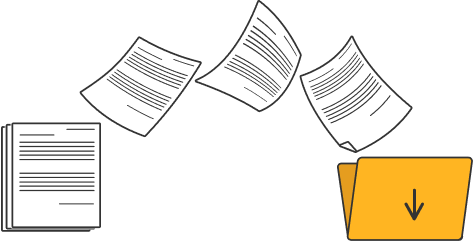Confusing Data Communication Concern
Turn Complex Data Into Clear, Compelling, and Actionable Messaging.
Implications of Confusing Data Communication
Data should clarify, not complicate. When numbers are presented without context or structure, readers are left guessing. Confusing charts, technical jargon, and missing narratives reduce trust and slow decision-making. Whether in dashboards, reports, or presentations, poor data communication wastes time and obscures value. With the right strategies, your team can present data in a way that informs, persuades, and drives action.
Writing Habits That Hurt Business
Many professionals fall into the trap of assuming the data speaks for itself. In reality, most documents need narrative framing and clear visuals. Without this, teams end up with reports that confuse more than clarify, which weaken the impact of critical insights.
Frequent Rewrites
Lack of clarity forces teams to revise reports repeatedly, delaying decisions.
Unclear Reports
Data-heavy documents often fail when they lack narrative structure and key takeaways.
Proposals that Don’t Win
Proposals fall flat when data is unclear, irrelevant, or not linked to client needs.
Unclear Purpose
When writers don’t define what the data is meant to show, readers can’t interpret it effectively.
If any of these hit home, consider our Writing Workshops.
What Causes Confusing Data Communication?
Poor data communication usually stems from a lack of strategy. Writers often present numbers without context or fill pages with visuals that add noise rather than meaning. Teams may not know how to tailor content to the reader or draw conclusions from the data. Hurley Write’s training helps teams turn complex data into clear, reader-friendly narratives that support smarter decisions.
Data Presented Without Context
Data must tell a story; when it doesn’t readers are left to interpret for themselves, which can result in misinterpretation.
Visuals That Mislead or Overwhelm
Busy charts or graphs without labels, structure, or purpose reduce understanding instead of adding value.
Ignoring the Story Behind the Numbers
Without insights or conclusions from the writer, even accurate data fails to deliver impact.
Mixing Technical Detail with Strategic Insight
When documents jump between depth and summary with no structure, readers get lost.
Inconsistent or Unclear Data Terminology
Different terms for the same metrics confuse readers and create misalignment.
Lack of Audience Segmentation in Reports
When content is not tailored to the audience’s level of expertise, engagement drops.
Overuse of Raw Data Without Interpretation
Presenting too many figures without filtering or summarizing buries what matters most.
No Framework for Prioritizing Key Findings
Without a system to highlight priorities, critical points may be lost in the noise.
Workshops That Remedy Confusing Data Communication
Hurley Write’s workshops teach professionals how to make data meaningful. We show teams how to frame, organize, and present information in a way that supports clear storytelling and confident decision-making. Whether it’s a quarterly report or a project dashboard, our courses help professionals communicate insights clearly and with purpose.
Business Writing Workshops
Helps teams translate data into business language that is actionable and aligned with audience goals.
Manufacturing Writing Workshops
Teaches process-driven teams how to structure technical data for both internal and external readers.
Online Writing Courses
Offers self-paced modules that teach data storytelling skills and visual clarity for any document.
Next Steps: Improve Your Team’s Writing Today
Let’s discuss your team’s unique writing challenges. We’ll evaluate writing samples and recommend a customized solution designed to improve clarity, productivity, and results.

Don't take our word for it, see what our clients have to say.
For 35+ years, we’ve shown organizations how to improve their communication, whether that involved designing and teaching writing and/or reviewing workshops, improving their writing and/or reviewing tools, offering individualized coaching, or helping them put processes in place.
And we can help your team of professionals, too!
Jacueline Davis
IDA

Andrew Charles
Bristol Myers Squibb

Aylia Thomas
John Deere

Aylia Thomas
Orica US

Mike Brett
Raytheon

David Anderson
DTCC

Judy Lettington
PaxVax

Gregory Marshall
D & H Global Tax Group

William Walters
IDA

Mike Brett
conEd

Dan Littlefield
Genentech

Simon Matthews
Raytheon

Frequently Asked Questions
How do I know if our data communication is unclear?
If readers struggle to interpret charts, misinterpret key metrics, or request clarification often, the data may not be clear.
Can your workshops help our team simplify complex data?
Yes. We teach methods for filtering, structuring, and presenting data clearly, no matter the complexity.
Do you teach how to tailor data presentation for different audiences?
Absolutely. We help teams segment and adapt data content to suit technical and non-technical readers.
What types of documents or presentations do you cover in training?
Our training applies to dashboards, internal reports, client presentations, technical documents, and more.
How do you address the balance between technical detail and clarity?
We show teams how to decide what to include, what to explain, and how to guide the reader through the content.
Are the workshops suitable for teams that rely heavily on charts and visuals?
Yes. We provide guidance on visual clarity, formatting, and data storytelling techniques that improve understanding.
Can we use our internal reports or dashboards during the training?
Yes. We encourage using your team’s real materials so the lessons are practical and immediately applicable.


